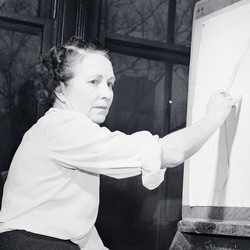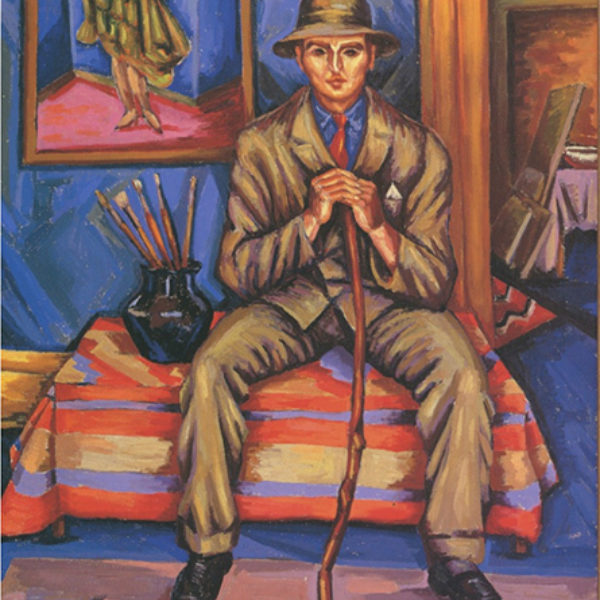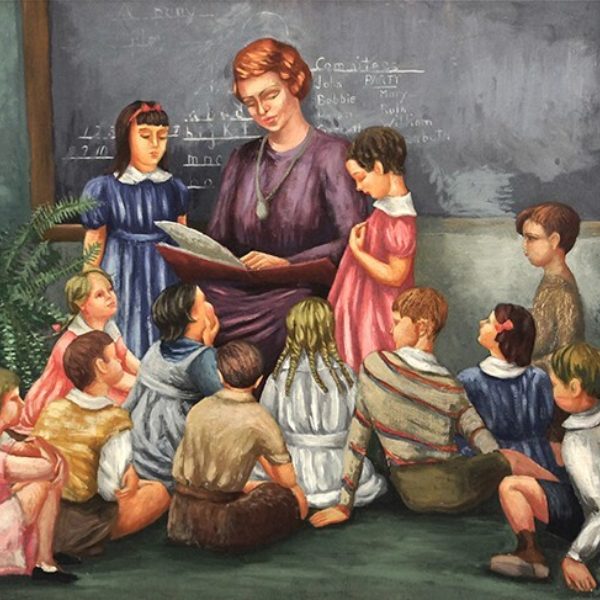
Frances Strain
b. 1898, Chicago, IL - d. 1962, Chicago, IL
Frances Strain was born in Chicago to James C. Strain, an Irishman involved in Cook County politics, and a Danish immigrant mother. Her father died in 1907, leaving her mother emotionally withdrawn and without an income. Frances’s half-sister, Dedie, about twenty years her senior, took over financial support of the household, which also included a younger sister, Virginia. The family lived on the Near West Side before relocating to Hyde Park, where Frances spent most of the rest of her life. She knew from childhood that she wanted to paint, but did not meet an artist until she began her studies at the School of the Art Institute of Chicago (SAIC) during World War I. Like many of the progressive artists of this generation, she studied with George Bellows and Randall Davey, New York artists associated with the Ashcan School of urban realism, who each taught for short stints at the SAIC in the 1919–20 academic year. These artists stressed personal expression, sincerity, and liberation from the rule-bound pedagogy that prevailed at the time. Along with a group of students that included her future husband, Fred Biesel, Strain was invited to join Davey in Santa Fe, New Mexico, for the summer. There she met a number of artists, including John Sloan, one of the most important of the Ashcan School painters and president of the Society of Independent Artists (SIA) in New York. Strain and Biesel returned to New York with him at the end of the summer. The couple lived and worked with Sloan for more than a year, returning to Santa Fe with him the following summer. With Sloan as teacher, the students extended their understanding of the Bellows-Davey philosophy of freedom of expression and met numerous artists and writers, most of whom were actively involved in the SIA. Strain and Biesel maintained a lifelong relationship to Sloan, and many of the connections forged in New York were significant when Strain began to organize exhibitions at the Renaissance Society of the University of Chicago, where she became exhibition director in 1941. Although the couple returned to Santa Fe almost every summer during the 1920s, by 1922 they had established themselves in Chicago, eventually renting a small studio in the South Shore neighborhood, doing commercial work as well as fine art, and becoming important figures in the progressive artistic community of Chicago.
Strain was actively involved in almost every independent exhibition and exhibition group that emerged in Chicago during the 1920s and 1930s. She exhibited in the single Chicago show of a group of mainly New York independents called the Introspectives in 1921, followed by participation in the 1922 Salon des Refusés, consisting of a large group of paintings rejected by the jury of the American Annual at the Art Institute of Chicago that year. The latter exhibit represented the beginning of the no-jury mentality in Chicago and led to the founding of the Chicago No-Jury Society of Artists, which held their first show in the same year. Modeled on the SIA, the group offered any artist who wished to exhibit the opportunity to do so, even hanging the work alphabetically to avoid any whiff of hierarchical treatment. The group was predicated on egalitarianism and democracy, and was long-lived for a organization of this kind, holding exhibitions into the 1950s. Strain and Biesel, who held leadership positions in the society, were able to successfully encourage many of their New York friends to exhibit in Chicago, lending a national flavor to the No-Jury shows.
After living together for several years, Strain and Biesel married in 1926, and in 1928 joined two other artist couples who were close friends—Vin and Hazel Hannell and Gus Dalstrom and Frances Foy—on a working trip to Europe. Untitled (Le Selecte), made during the visit, depicts a busy street scene in Paris. Although Strain worked in a number of styles, this image is related to the Ashcan school’s focus on ordinary urban scenes executed with a seemingly effortless rapidity, giving the scene a feeling of lively activity. In the same year they purchased property in Furnessville, Indiana, near the Indiana Dunes, that was to become a refuge and summer home, a place to enjoy nature and family for the rest of their lives. Their only child, Garnett, was born in 1930. Strain was established by this time and her work was exhibited at progressive private galleries as well as with artists groups such as the Chicago Society of Artists and the SIA in New York. Her work was included in group shows at the Newark Museum (1927) and the Whitney Museum (1933), as well as the juried annuals at the Art Institute of Chicago. In 1928, she and Biesel, the Dalstroms, Vin Hannell, and five others artists formed 10 Artists of Chicago, a group characterized by its commitment to modernist ideals and its stylistic moderation. She participated in the government supported art projects of the 1930s, working in the easel division of the Illinois Art Project.
The charming images of Lars Dalstrom and Garnett’s First Grade Class at the U of C Lab School are characteristic of the work of the 1930s, when Strain used heavy application of paint in luscious colors in her portraits and still lifes. Strain often painted children as well as portraits of close friends, employing a kind of expressionist distortion of shape, size, and space in combination with rich surface textures and brilliant colors without the kind of angst or tension associated with the European style. In The Visitor (Emil Armin), for example, Armin, with whom Strain and Biesel worked in the Southwest, is surrounded by mementos from those trips as well as a painting by Fred Biesel on the wall.
Strain’s experience organizing exhibitions for the No-Jury Society and 10 Artists prepared her for her job at the Renaissance Society, which became a preeminent site for exhibitions in the Chicago area in the 1940s and 1950s under her leadership. Her relationships with artists and administrators in other cities made it possible for her to bring first-rate shows to the city. She showed the same commitment to Chicago artists as she did to those who worked elsewhere, including them in both national and international group exhibitions. The Renaissance Society brought everything from Asian to medieval to contemporary art to Chicago audiences, and Strain administered the gallery almost single-handedly, organizing and installing as many as nine shows a year, doing publicity and fund raising, and coordinated with the University of Chicago art history department and her board of directors.
In her accomplishments as an artist, a leader of progressive artists’ organizations, and as an administrator and curator, Strain made an enormous contribution to the artistic life of the city, giving the public the chance to see art from various cultures and many living artists an opportunity to show their work.
Susan Weininger
References
Biesel Family Papers. Smithsonian Institution. Archives of American Art.
Bulliet, C. J. “Artists of Chicago Past and Present: Frances Strain.” Chicago Daily News, March 21, 1936.
Greenhouse, Wendy, and Susan Weininger. Chicago Painting 1895–1945: The Bridges Collection. Exh. cat. Springfield: University of Illinois Press and Illinois State Museum, 2004.
Jacobson, J. Z. Art of Today: Chicago, 1933, 126. Chicago: L. M. Stein, 1932.
Scanlan, Joseph, ed. A History of the Renaissance Society: The First Seventy-Five Years. Chicago: The Renaissance Society, 1993.
Weininger, Susan. “Frances Strain.” In Elizabeth Kennedy, ed. Chicago Modern, 1893–1945: The Pursuit of the New, 153. Exh. cat. Chicago: Terra Foundation for the Arts, 2004.
——. “Frances Strain Biesel.” In Women Building Chicago 1790–1990, edited by Rima Lumin Schultz and Adele Hast, 854–56. Bloomington and Indianapolis: Indiana University Press, 2001.
Artist image: Photograph of Frances Strain, collection of Bernard Friedman.

